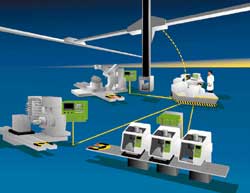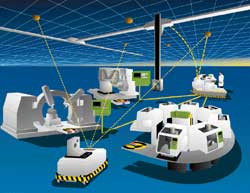Engineering Research Center for Reconfigurable Machining Systems
The University of Michigan, Ann Arbor
![]()
Creating the new manufacturing paradigm exactly the functionality and capacity needed, exactly when needed
| A National Science Foundation Engineering Research Center since 1996 |
![]()
|
Definition of Reconfigurability:
|
Manufacturing companies in the 21st Century will face frequent and unpredictable market changes. These changes include high-frequency introduction of new products, new product demand and mix, new parts for existing products, new government regulations, and new process technology. To stay competitive, manufacturing companies must possess manufacturing systems that are fully and rapidly responsive to all these variables.
A responsive system incorporates a production capacity that is adjustable to fluctuations in product demand, is adaptable to new product functions, and is designed to be upgradable with new process technology to accommodate evolving product specifications and government regulations. Current systems, even so-called flexible manufacturing systems, do not have these characteristics.
A new manufacturing paradigm reconfigurable manufacturing systems (RMS) will position manufacturing companies for the 21st century and ultimately will have as big an impact on industry as mass-production and lean manufacturing have had in the 20th century. Maybe bigger.
The aim of RMS is to design systems, machines, and controls for cost-effective, rapid response to changes in market demand and products. Methodologies for the systematic design and rapid ramp-up of RMS are the cornerstones of this new manufacturing paradigm. The new reconfigurable manufacturing paradigm provides exactly the functionality and capacity needed, exactly when needed.
Reconfigurability is defined (see box) as the ability to adjust the production capacity and functionality of a manufacturing system to new circumstances through rearrangement or change of the system's components. "Components" could be machines and conveyors in whole systems, mechanisms in individual machines, new sensors, or new controller algorithms. "New circumstances" may be changing product demand, producing a new product on an existing system, or integrating new process technology into existing manufacturing systems.
Reconfigurable manufacturing systems will be open-ended, so that they can be improved and upgraded rather than replaced. They will allow flexibility not only in producing a variety of products, but also in changing the system itself. The key is that this type of system must be designed at the onset to be reconfigurable, and must be created from basic hardware and software modules that can be arranged quickly and reliably.
The University of Michigan Engineering Research Center (ERC) for Reconfigurable Machining Systems is developing a new type of evolving factory that contains an RMS. This system is designed to be altered as needed, including changing the structure of its machines and controls. The RMS Center is developing analytical tools and methodologies that will:
- Reduce design lead time and ramp-up time of both new and reconfigured manufacturing systems
- Allow for rapid incremental changes in manufacturing capacity in response to market demand variations
- Allow reconfiguration of existing manufacturing systems to quickly produce new products and parts
- Allow new process technology to be integrated into existing production systems.
Research
 |
| First installation of the reconfigurable factory. It includes only the required capacity and functionality needed for a specific part family. For example, the reconfigurable milling machine (left) has a single spindle unit on one side. |
The barrier to developing reconfigurable systems is the lack of a scientific approach in designing optimal, scalable configurations of systems that include reconfigurable hardware and reconfigurable software. Using the focused yet highly complex domain of machining systems, the Center is contributing to a knowledge base that could become known as "reconfiguration science." The reconfiguration science will allow rapid, cost-effective reconfiguration of RMS regardless of the specific production technology (machining, assembly, semiconductor fabrication, etc.).
An RMS enables design of the system at the outset for cost-effective reconfigurability and rapid adaptation of the system's manufacturing capacity and its machine functionality. The potential of cost-effectiveness and rapid adaptation is realized by combining the flexibility of computer numerically controlled (CNC) configurations with the high production rate of dedicated lines in a systematic method, and the design of machines with changeable structure around part families. The goals of RMS research include developing methodologies for: (1) computer-aided design (CAD) for manufacturing systems of part families; (2) design of a new generation of reconfigurable machine tools (RMTs) along with their open-architecture controllers; and (3) rapid, systematic ramp-up after reconfiguration to minimize the sale-loss opportunity.
 |
| Two years later, in response to a new product that must also be produced on the same RMS, a second spindle unit was installed on the reconfigurable, arch-type machine, and an autonomous vehicle was added. To accommodate the increased production capacity, additional machines were added on the reconfigurable conveyor. The factory controller was reconfigured to handle the additional equipment. |
Accordingly, the Center's research is organized into three Clusters of Projects (COPs): System-Level Design; Machine/Control Design; and Calibration and Ramp-Up. Integration among research projects is being established via a machining testbed that has three components: (1) virtual factory as an aid to system design; (2) prototype RMTs to verify the RMT design theory; and (3) hardware testbed of several machines to verify ramp-up methodologies.
COP 1 System-Level Design
Goal - Reduction in design lead-time for developing mathematical tools for cost-effective reconfigurable manufacturing systems.
Objectives - Develop (1) a "system-level configurator" a set of algorithms and synthesis laws applicable to the design of RMSs for part families; (2) system configuration optimization methodology based on reliability, quality, and system scalability principles; (3) life-cycle economic modeling of large systems; and (4) a method to evaluate reconfigurable material handling systems.
COP 2 Machine-Level Design
Goal - Development of a methodology for the design of a new generation of reconfigurable machine tools and their reconfigurable controllers.
Objectives - (1) Develop a reconfiguration design theory based on a systematic synthesis of machine modules and their associated processes; (2) design recon-figurable machines, constructed from a set of generic modules, which enable the machining of a family of parts; (3) create integration tools that can quickly configure discrete logic control systems; (4) develop self-calibration, self-diagnosis techniques for machine tools and their spindles; and (5) define principles of open architecture controllers.
COP 3 Ramp-Up and Calibration
Goal - Development of systematic methods for the reduction in ramp-up time for reconfigurable machine tools and reconfigurable manufacturing systems.
Objectives - Develop (1) a stream-of-variation theory (a systematic approach to the reduction of ramp-up time through process knowledge, diagnostics, and root-cause analysis); (2) reconfigurable monitoring and diagnostics of machining processes; and (3) optical sensing techniques for real-time part measurement.
The Center is founded on five discipline-based research thrust areas:
- System Design and Integration
- Software Architecture and Information
- Measurement and Controls
- Mechanical Design
- Processes and Tooling.
The five thrust areas and the three COPs together create a matrix organization for a research program that contains some 15 projects. The Center includes 25 faculty, 10 research scientists, 40 graduate and 40 undergraduate students from Mechanical, Industrial, and Electrical Engineering & Computer Science Departments of the College of Engineering, as well as the UM School of Business Administration. In addition, the Center has developed activities that integrate the projects in each of the COPs via case studies and testbed demonstrations.
Case Studies in Industry Plants
Students are working in the industrial plants to study reliability and diagnostics problems in machining systems. The COPs are utilizing the data collected.
Testbed
An experimental testbed demonstrates the technology-base for RMS. It contains:
- A virtual factory built with software to demonstrate system design methodologies
- Prototype reconfigurable machines to demonstrate concepts of reconfiguration in machines and their controllers
- A hardware testbed consisting of several machines and part measurement to demonstrate ramp-up methodologies.
Education
A primary objective of the RMS Center is to develop a new generation of manufacturing engineers, more effective in industry and better positioned to lead system-level R&D in a global economy. Industrial experience through internships as well as communication and team-building workshops are integral to ERC student education. The Center developed two graduate-level courses on RMS and introduced a Manufacturing option for undergraduates.
The ERC offers research assistantships and supports financially over 40 graduate and 40 undergraduate students.
The Center is a designated NSF Research Experiences for Undergraduates (REU) site and, as such, hosts students from underrepresented minority groups each summer. Summer programs also include workshops on leadership in global economy, project management, communication skills, and team building. The ERC offers short summer courses to member companies. Later, training programs for future end-users of RMS technology will be developed.
Industrial Collaboration/Technology Transfer
Over 30 industrial companies are the founders of the Center. They include suppliers such as machine tool builders, control vendors, and software companies, as well as three end-user sectors: aerospace, heavy equipment, and automotive.
There are two levels of membership: Regular Member and Associate Member. Regular Members pay an annual fee, are entitled to free access to Center intellectual property, and may be elected to the Center Executive Committee. The responsibilities of both Regular and Associate membership include participation in specific research projects and contribution of manpower, equipment, software, or other in-kind services. The benefits include participation in semiannual program reviews, utilization of software developed in the Center, recruiting ERC students, and advising the Center Director on the research programs.
Industry partners can be involved in Center activities in four different ways:
- The Executive Committee recommends strategic direction and oversees the budget.
- The Design & Integration (D&I) Team recommends technical direction.
- The Technical Advisory Committee (TAC) includes all the Center's industry members and conducts semi-annual meetings in May and October to evaluate all Center projects.
- Every project has industry partners that meet frequently with the researchers to advise and monitor progress.
The RMS Center will work with commercial software vendors to commercialize the software packages developed in the Center, and with machine builders and control vendors to commercialize the Center's hardware inventions. Since its inception the Center has applied for four U.S. patents dealing with reconfiguration methodologies, and was granted one patent on "Reconfigurable Machine Tools."
(U.S. Pat. #5,943,750).
![]()
Center Headquarters
Engineering Research Center for Reconfigurable Machining Systems
College of Engineering
University of Michigan
2250 G. G. Brown Building
2350 Hayward Street
Ann Arbor, MI 48109-2125
Tel (734) 763-9999 · Fax (734) 763-5700
Homepage: http://erc.engin.umich.edu/
Center Director: Dr. Yoram Koren
ykoren@umich.edu
Deputy Director: Dr. A. Galip Ulsoy
ulsoy@umich.edu
NSF 00-137l